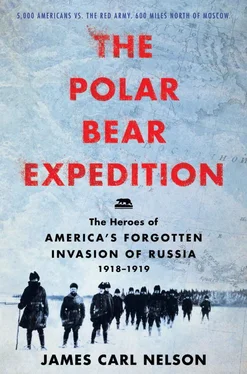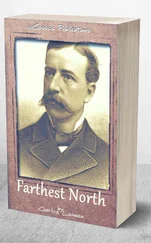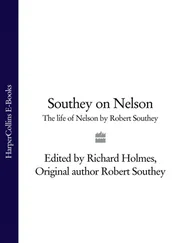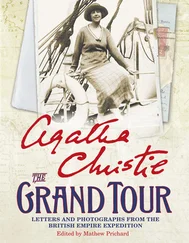Pershing selected the 339th for three reasons: One, it was already in England. Two, its commander, Col. George Evans Stewart, then forty-six, had spent the past twenty-plus years in service, had earned a Medal of Honor in the Philippines in 1899, and had subsequently spent two cold years in Alaska. Three, it was thought, and perhaps rightly so, that men who were mostly from the colder northern states of Michigan and Wisconsin could more easily bear the deep freeze of a Russian winter than those from the southern states.
One of the first inklings of the change in plans had been conveyed to Harry Mead. While in London during the 339th’s three-week stay at a camp just outside the city of Aldershot, Mead had run into the globetrotting self-promoter and quasi-journalist Lowell Thomas, who had boarded with Harry’s family while attending Valparaiso University for two years.
As Thomas, just returned from his adventures with British colonel T. E. Lawrence—whom Thomas would almost personally make famous as Lawrence of Arabia—and Mead chatted on a street corner, Mead mentioned that his regiment expected to leave for France soon. Thomas, who had sources in the British government, set his friend straight, telling Mead that his information was that the 339th was being rerouted to, of all places, northern Russia.
Soon, there were other not-so-subtle hints as to the regiment’s future destination. Ernest Shackleton, the famed Antarctic explorer who had recently and only just survived the sinking of his ship Endurance in the polar ice and a subsequent harrowing, eight-hundred-mile sea voyage in an open boat to seek rescue for his crew, was brought in to lecture the regiment’s men on the conditions in the Arctic.
He had plenty to tell them: Shackleton had been on three separate expeditions to Antarctica, including two attempts on the South Pole: the first with Robert Falcon Scott from 1901 to 1903, the second between 1907 and 1909, when Shackleton and his small party sledge-hauled to within ninety-seven nautical miles of their target. On his third expedition, an attempt to cross the continent between 1914 and 1916, his ship became trapped in the ice and was crushed after ten months of drifting.
The party eventually reached a refuge—tiny Elephant Island—after which Shackleton and five others made their death-defying journey by open boat to the whaling station at South Georgia Island. From there, Shackleton mounted a rescue party and made it back to Elephant Island, where his men were still alive and waiting. He returned to England to find a war on, and served in the British Army until its end.
Their polar briefings done, on August 20 the men of the 339th were told to turn in their Lee-Enfield rifles, and in turn were supplied with Mosin-Nagant 7.62 rifles—“guns made in America, purchased by the Russia of the Czar, and stored near Aldershot awaiting shipment to the Russian Imperial Army which had collapsed,” a bemused Harry Costello would write.
Lt. John Cudahy, the scion of a wealthy Wisconsin family who served with the 339th’s Company B and would one day serve as President Franklin Roosevelt’s ambassador to Poland and later Belgium, characterized the clumsy rifles that had been intended for Russian hands as “long, awkward pieces, with flimsy, bolt mechanism, that frequently jammed.”
What’s more, the weapons had been sighted “in Russian paces instead of yards. They had a low velocity and were thoroughly unsatisfactory.” Still others would joke that the rifles could “shoot around corners.” However, the issuing of them had some reasoning; a large cache of ammunition for the weapons was supposed to be available and waiting for the men in Russia.
Gone, too, were the Browning machine guns that Costello and his mates had learned to master. They were instead issued water-cooled Vickers guns, which would freeze and prove troublesome to operate in the deep, deep cold of a Russian winter.
As the regiment made ready to leave southern England, the men received more lectures, this time from the British, whose officers would lead the coming grand adventure.
“Their one great thought was well expressed to me by an enthusiastic staff officer,” Costello wrote. “‘We’ll just rush up there and reestablish the great Russian Army—reorganize the vast forces of the Czar! Russia’s former great armies will rise to welcome us.’”
“‘One good Allied soldier can outfight twenty Bolsheviks,’ was the usual boast of the Commanding Officer in the early days of the fighting,” Cudahy would add.
The men of the 339th also received new woolen British clothing and winter supplies—including the “Shackleton boot,” which had been designed by the explorer expressly for work in polar regions. However, moving about in the mukluk-type footwear would prove to be a frustrating and slippery task, and on some occasions the men would be reduced to tossing them away and walking through deep snow and over frozen trails in just their wool socks.
Some in the regiment took news of their destination in stride. “Company notified we are going to Russia,” Sgt. Gordon Smith of Company D wrote nonchalantly in his diary on August 22. “Turned in Enfield Rifles and draw Russian equipment.”
Others were crushed “to have missed the Big Show and be sent instead to an unknown country to fight an unknown enemy for an unknown reason,” as Dorothea York, the author of the 1923 book The Romance of Company “A,” would put it.
On August 25, the 339th once more boarded trains and headed north, instead of east for France. At Newcastle, the men boarded the transports Somali , Nagoya , and the Tydeus , while a contingent of Italian troops also bound for the unknown loaded onto the Czar .
In the early morning the four ships, plus a convoy of four British warships, slipped their moorings and stole down the Tyne River and toward the North Sea. Aboard the cramped Somali , Godfrey Anderson found space in the hold, and “managed to get a fairly good night’s sleep.”
Aboard the equally cramped Nagoya , the men found sleeping places in hammocks below deck. Quickly, conditions deteriorated.
“The ever-present cootie, rats and a number of other species of vermin repellant to man were present in force,” wrote York, whose Romance of Company “A” was based on the recollections of a number of the unit’s veterans.
“The air was fetid with packed humanity and there was no pretense of any system of ventilation… The stench from the hatchways was unmistakable warning against venturing below and yet one must go below for food and sleep.”
The Nagoya in her previous life had been a trade ship in the Asian Pacific, and she was in filthy condition. Before long, it was apparent, too, that she was a carrier of disease; within days of leaving port the dreaded and so-called Spanish influenza, which would kill 21 million people worldwide before running its course, was crawling through her decks, making dozens of men deathly ill.
The flu broke out on the Somali as well, as the ship rolled and fought through gray, leaden seas and toward the north. Seasickness also afflicted some, and as the convoy approached and then passed through the Arctic Circle the cold intensified but could not be remedied.
“Our overcoats had been packed in barracks bags and stored deep down in the hold so we could not put on the warmer clothing so badly needed,” Godfrey Anderson recalled.
“It is getting colder, men packed like sardines in impoverished hold, a number of men getting sick,” Company B’s Clarence Scheu would write on August 28 of conditions on the Nagoya .
Three days later, Scheu noted the deaths of several men from the flu: “Stormy and colder, sun not visible, see northern lights, hear several men die on board, there sure is a bunch of them getting sick.”
Читать дальше








